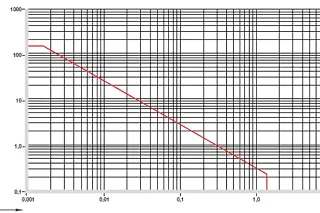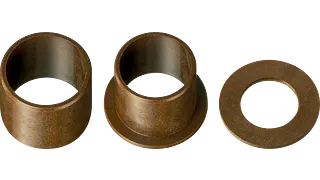Change Language :
iglidur® Z - material data
The most important specifications at a glance
Alongside iglidur X, iglidur Z is one of the most widely used iglidur high-temperature materials. Its excellent wear behaviour under external conditions (high loads and temperatures) is particularly noteworthy.
| Descriptive technical specifications | ||
|---|---|---|
| Wear resistance at +23°C | - 🟧 🟧 🟧 🟧 ⬜️ + | More information on wear resistance |
| Wear resistance at +90°C | - 🟧 🟧 🟧 🟧 ⬜️ + | |
| Wear resistance at +150°C | - 🟧 🟧 🟧 🟧 ⬜️ + | |
| Sliding properties | - 🟧 🟧 🟧 🟧 🟧 + | Coefficient of friction, dynamic, against steel: µ 0.06 - 0.14 |
| Wear resistance under water | - 🟧 🟧 ⬜️ ⬜️ ⬜️ + | |
| Media resistance | - 🟧 🟧 🟧 🟧 ⬜️ + | More information on media resistance |
| Resistant to edge pressures | - 🟧 🟧 🟧 🟧 🟧 + | |
| Resistant to shock and impact loads | - 🟧 🟧 🟧 🟧 🟧 + | |
| Dirt resistance | - 🟧 🟧 🟧 🟧 🟧 + |
Temperatures
The maximum permissible short-term temperature is +310°C. The temperatures prevailing in the bearing system also have an influence on bearing wear. Wear increases with rising temperatures. At high temperatures, iglidur Z is also the most wear-resistant material in dry operation. Additional protection is required at temperatures higher than +145°C.
Temperatures, coefficient of thermal expansion
| min. application temperature | Upper application temperature, long-term | Upper application temperature, short-term | In addition secure axially from |
|---|---|---|---|
| -100°C | +250°C | +310°C | +145°C |
Permissible surface speed
iglidur Z is a high-temperature material that is suitable for applications with very high specific loads. The maximum values specified in the table can only be achieved at low pressure loads. At the given speeds, friction can cause a temperature increase to maximum permissible levels. In practice, these limit values cannot always be achieved due to the interaction of different influences.
Surface speeds of various iglidur materials
| Maximum surface speeds [m/s] | Rotating | Oscillating | linear |
|---|---|---|---|
| Long-term | 1.5 | 1.1 | 5.0 |
| Short-term | 3.5 | 2.5 | 6.0 |
Permissible pv values

Diagram 01: Permissible pv value for iglidur Z plain bearing with 1mm wall thickness in dry operation against a steel shaft, at +20°C, installed in a steel housing
X = surface speed [m/s]
Y = load [MPa]
Mechanical specifications
The maximum recommended surface pressure is a mechanical material parameter. Conclusions about the tribology cannot be drawn from this. The compressive strength of iglidur Z plain bearings decreases with increasing temperatures. Diagram 02 illustrates this relationship. Diagram 03 shows the elastic deformation of iglidur Z under radial load. At 150MPa, the deformation is approx. 5.5%.
Friction and wear
The coefficient of friction decreases with increasing load, as does the wear resistance (diagrams 04 and 05).
Coefficient of friction against steel (Ra = 1μm, 50 HRC):
| iglidur Z | dry | Greases | Oil | Water |
|---|---|---|---|---|
| Coefficient of friction μ | 0.06 - 0.14 | 0.09 | 0.04 | 0.04 |
Shaft materials
Diagram 06 shows wear rates in the lower load range that are quite similar to those of other very wear-resistant iglidur materials. In the upper range, however, iglidur Z outperforms all other materials in terms of wear resistance. With e.g. a Cf53 shaft, the wear at 45MPa is only 15μm/km.
At low loads, iglidur Z plain bearings wear less in pivoting operation than in rotation. 304 stainless steel shafts and hard chrome-plated shafts are particularly noticeable here.
Chemical resistance
iglidur Z plain bearings have very good resistance to chemicals. They have excellent resistance to organic solvents, fuels, oils and greases. The material is only partially resistant to weak acids.
All data at room temperature [+20 °C], + resistant 0 conditionally resistant - non-resistant
| Chemicals | Resistance |
|---|---|
| Alcohols | 0 |
| Greases, oils without additives | + |
| Hydrocarbons | + |
| Fuels | + |
| Strong alkalines | - |
| Strong acids | - |
| Diluted alkalines | + |
| Diluted acids | + |
Moisture absorption
Installation tolerances
iglidur Z plain bearings are standard bearings for shafts with h-tolerance (recommended minimum h9). The bearings are designed for press-fit into a housing machined to a H7 tolerance. After installation in a housing with nominal dimensions, the inner diameter of the bearings with E10 tolerance adjusts automatically. For certain dimensions, the tolerance deviates from this depending on the wall thickness (see product range).
Important tolerances according to ISO 3547-1 after press-fit:
| Diameter d1 [mm] | Housing H7 [mm] | iglidur Z plain bearing F10 [mm] | Shaft h9 [mm] |
|---|---|---|---|
| up to 3 | +0.000 +0.010 | +0.006 +0.046 | -0.025 +0.000 |
| > 3 up to 6 | +0.000 +0.012 | +0.010 +0.058 | -0.030 +0.000 |
| > 6 up to 10 | +0.000 +0.015 | +0.013 +0.071 | -0.036 +0.000 |
| > 10 up to 18 | +0.000 +0.018 | +0.016 +0.086 | -0.043 +0.000 |
| > 18 up to 30 | +0.000 +0.021 | +0.020 +0.104 | -0.052 +0.000 |
| > 30 up to 50 | +0.000 +0.025 | +0.025 +0.125 | -0.062 +0.000 |
| >50 to 80 | +0.000 +0.030 | +0.030 +0.150 | -0.074 +0.000 |
| >80 to 120 | +0.000 +0.035 | +0.036 +0.176 | -0.087 +0.000 |
| > 120 up to 180 | +0.000 +0.040 | +0.043 +0.203 | +0.000 +0.100 |

Buy iglidur Z products in the online shop
- Large selection of moulds and materials
- Available within 24 hours
- No minimum order value
- No minimum order quantity
Typical areas of application
ASI Automatikk AS Distributor+47 9006 1100










